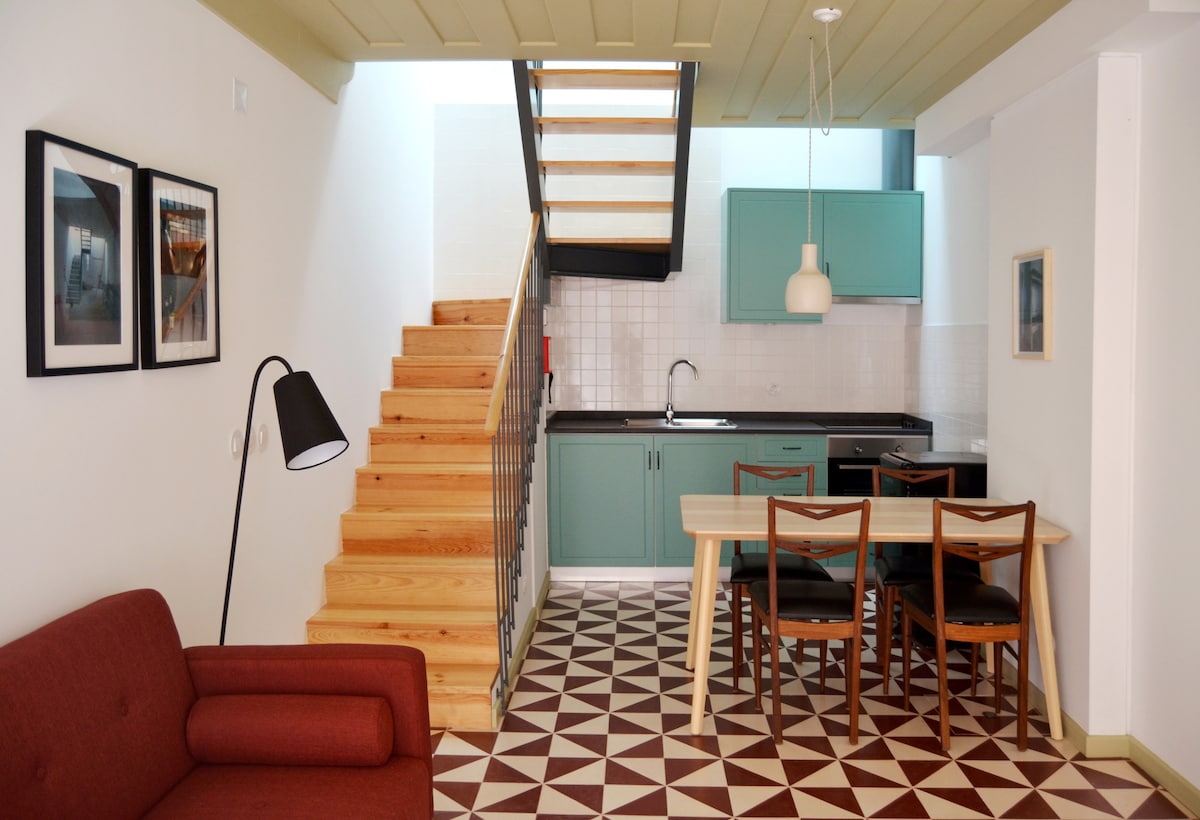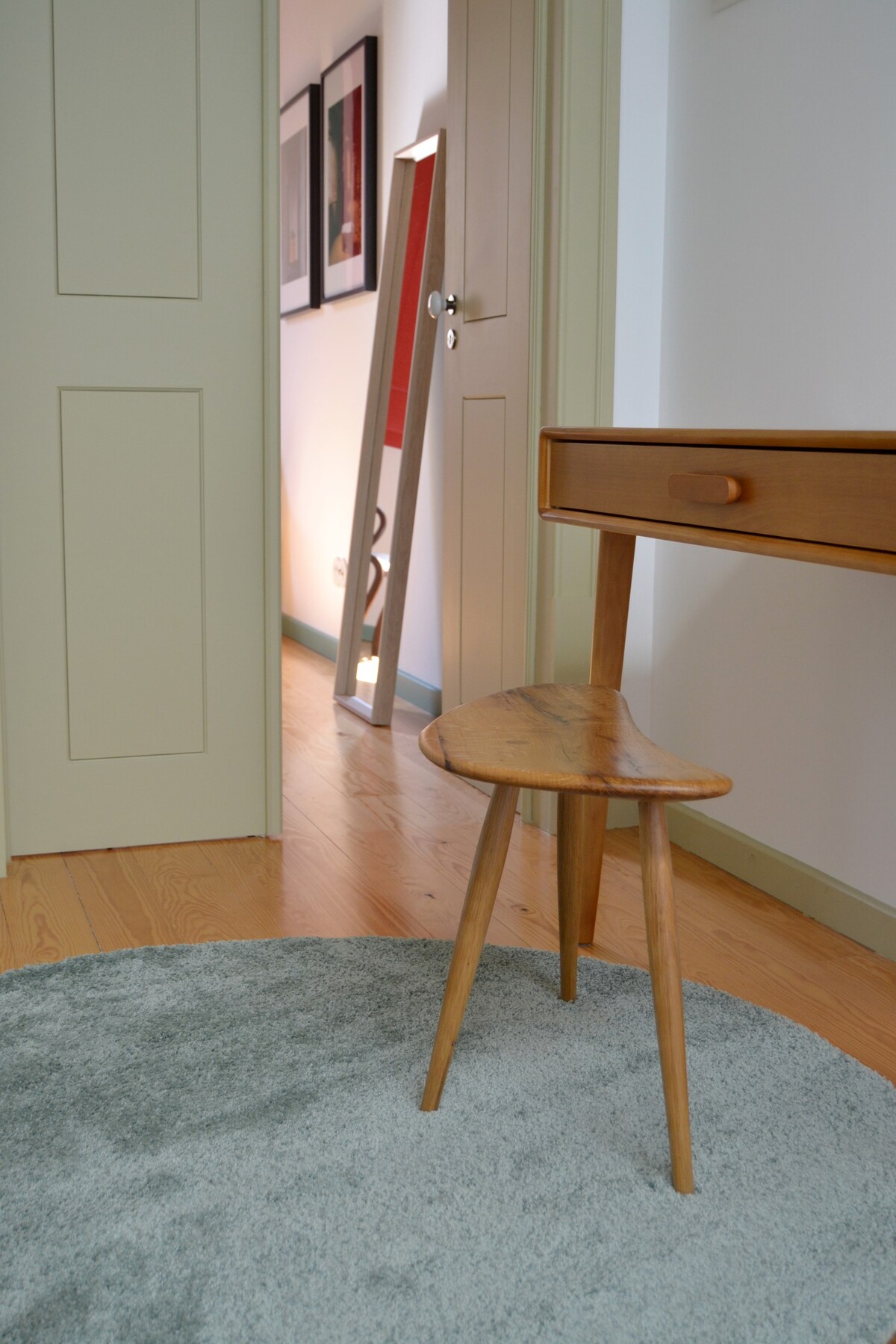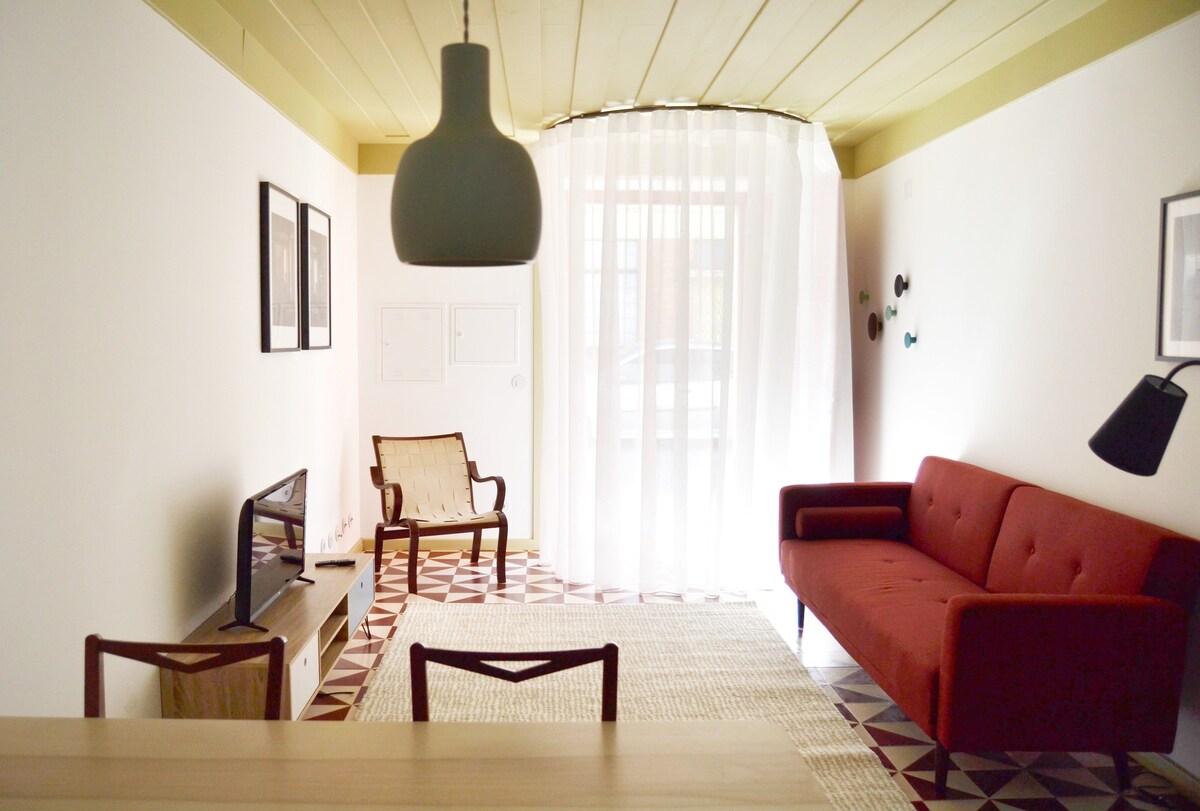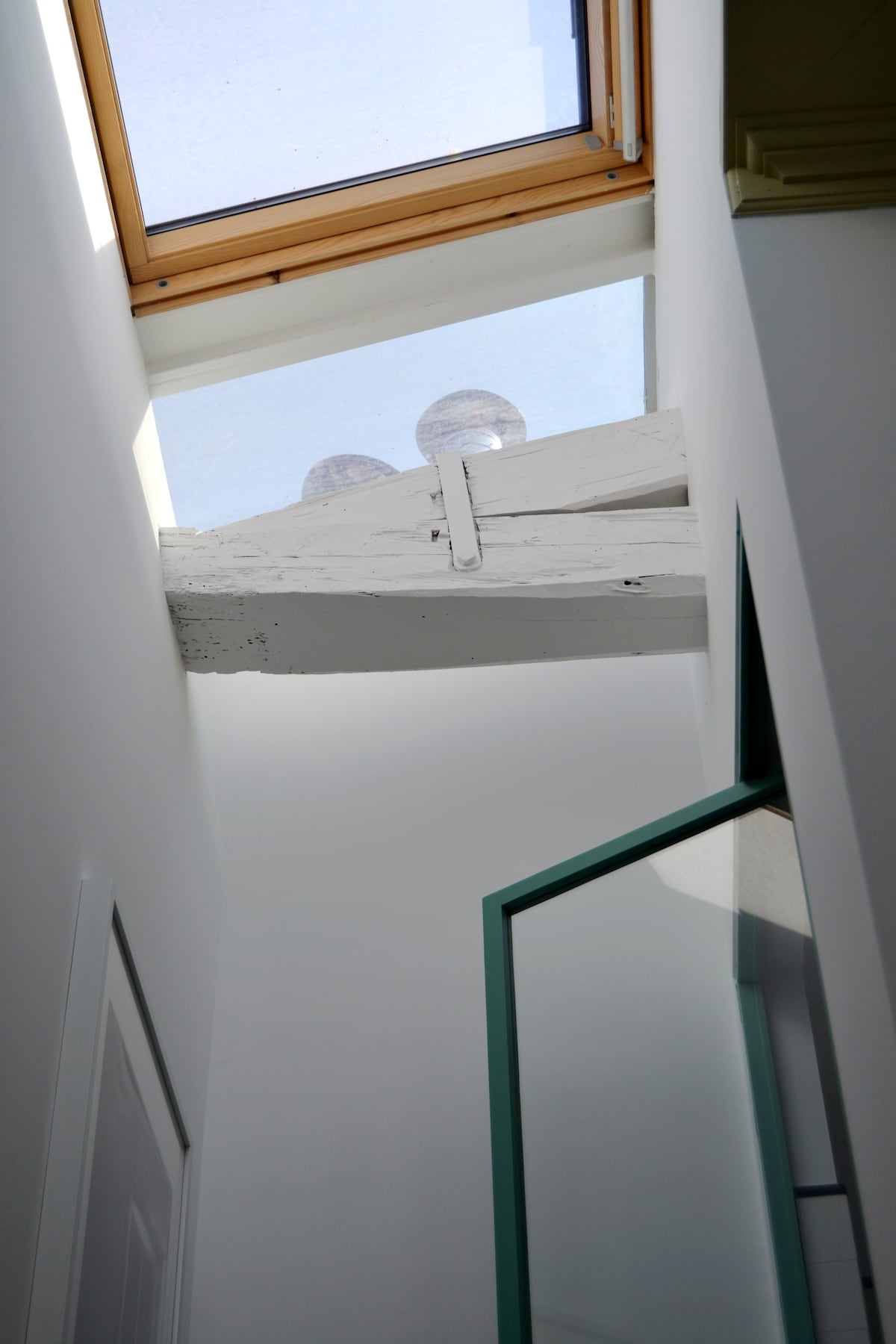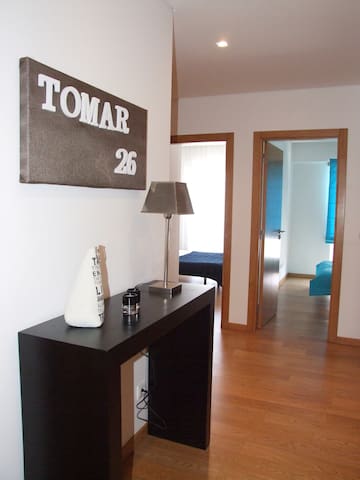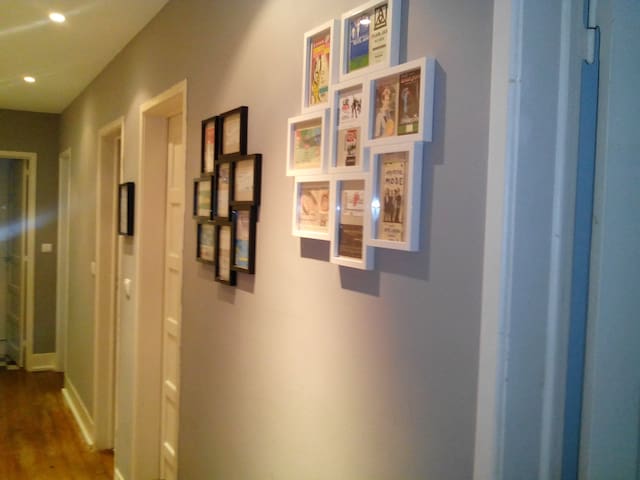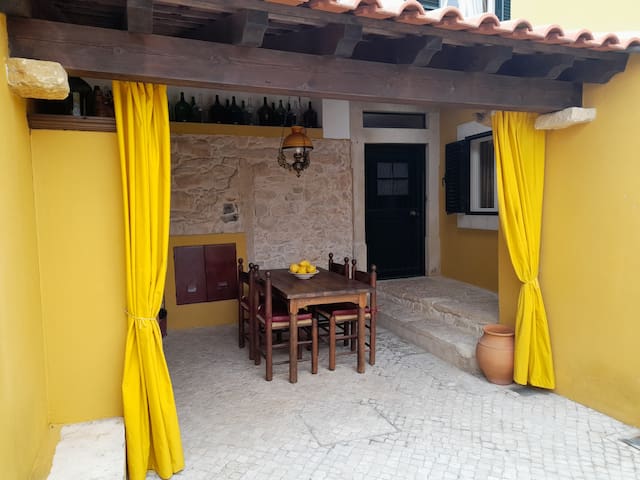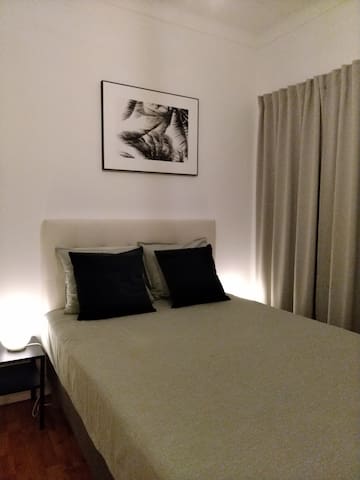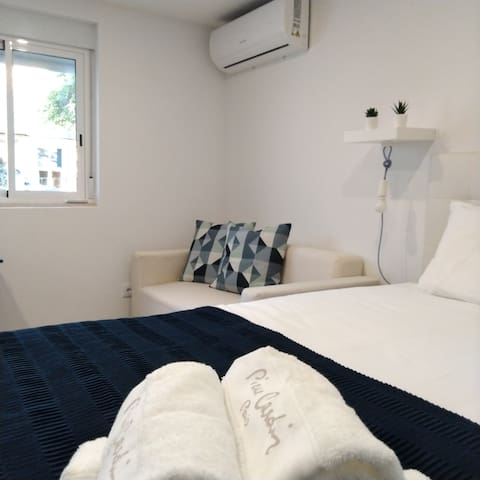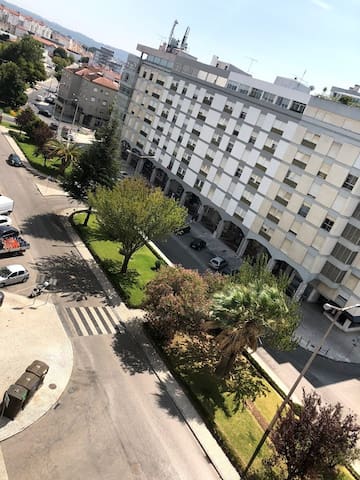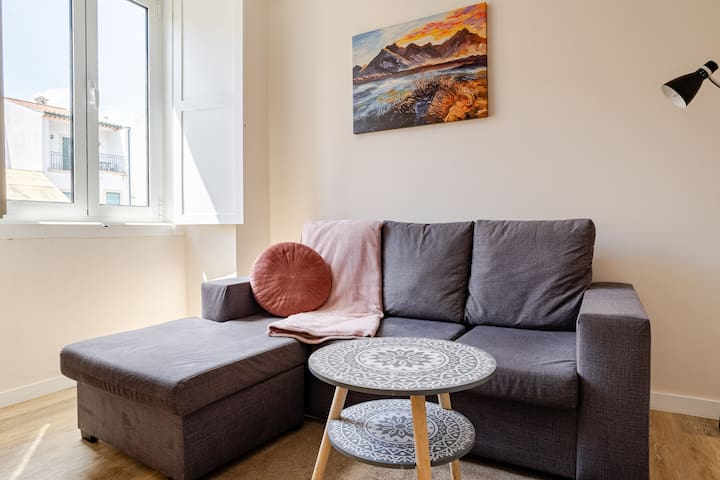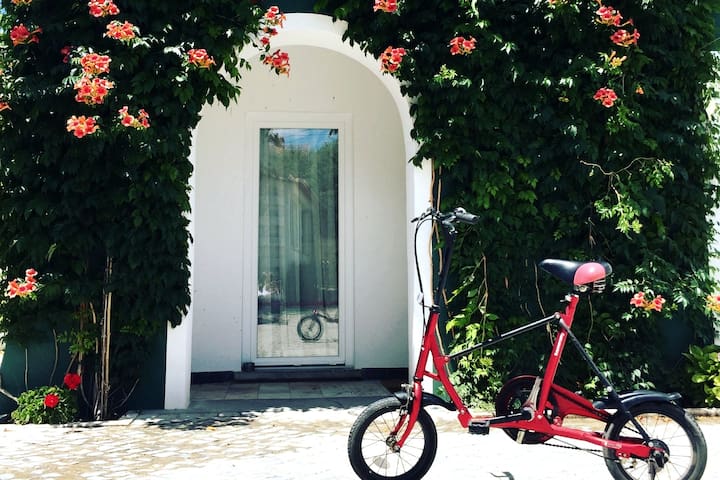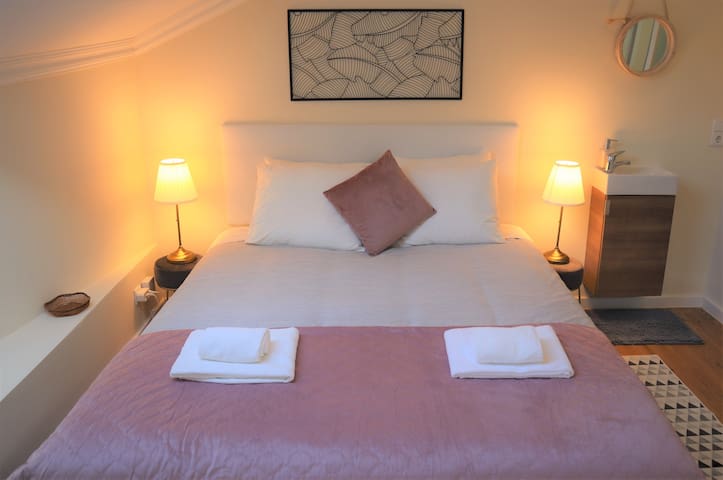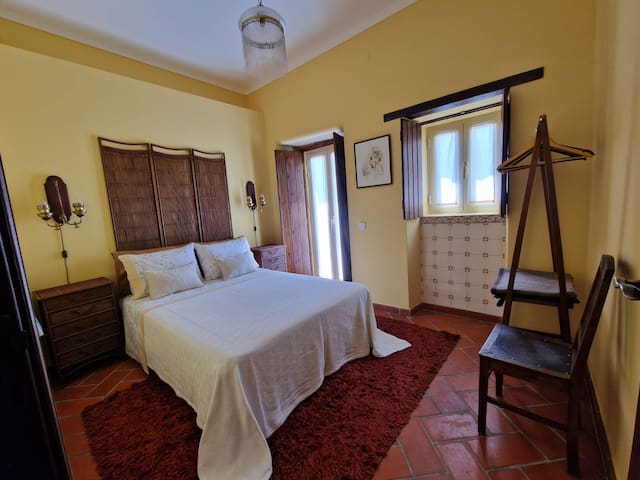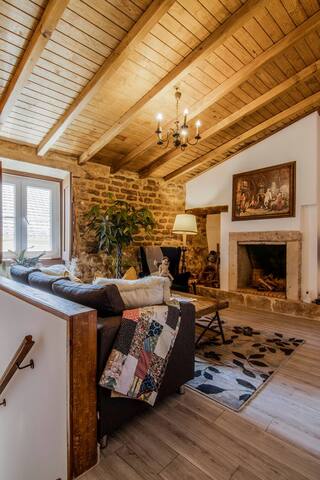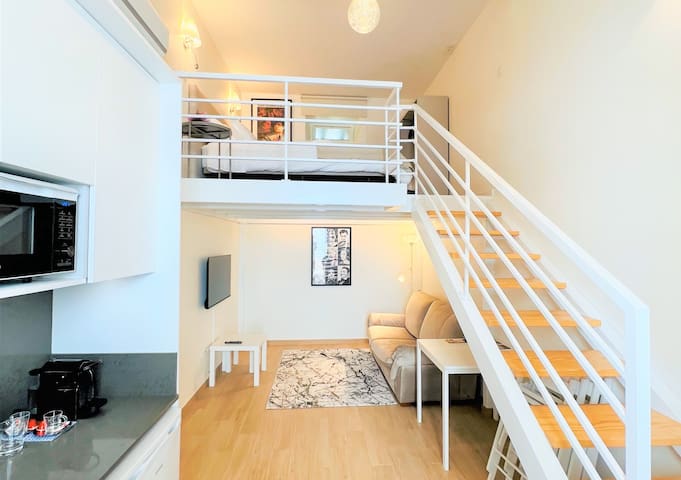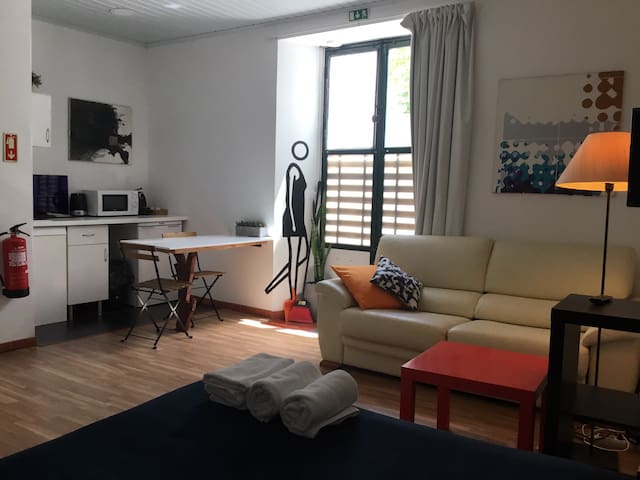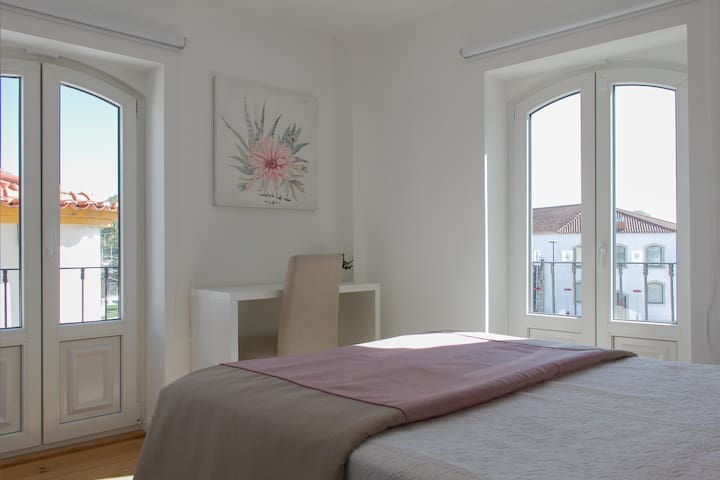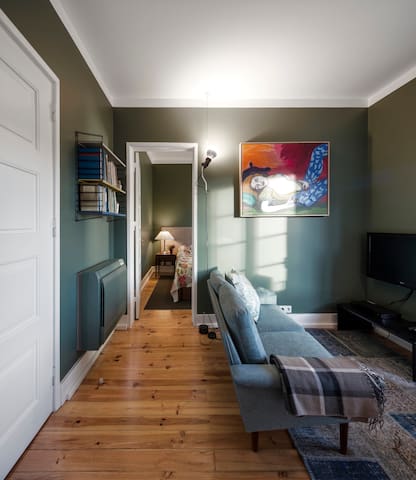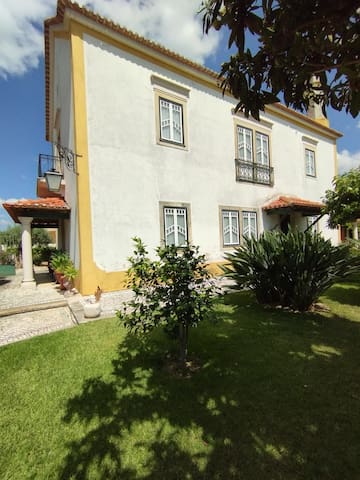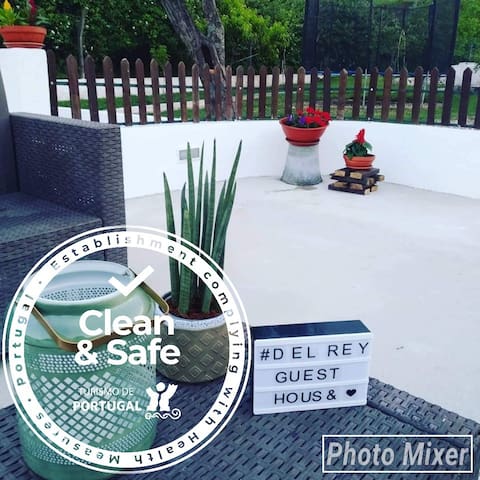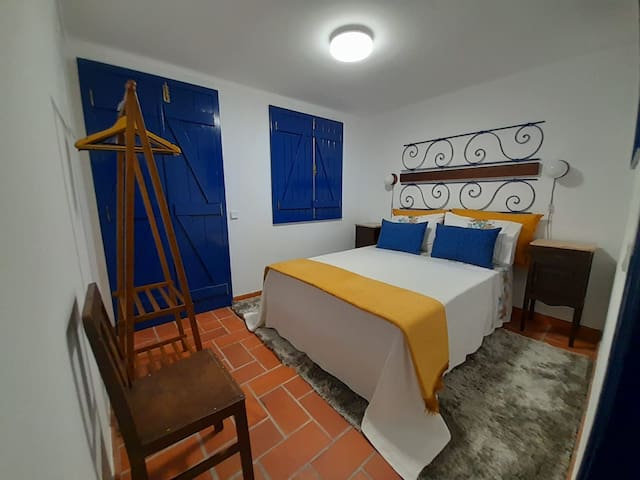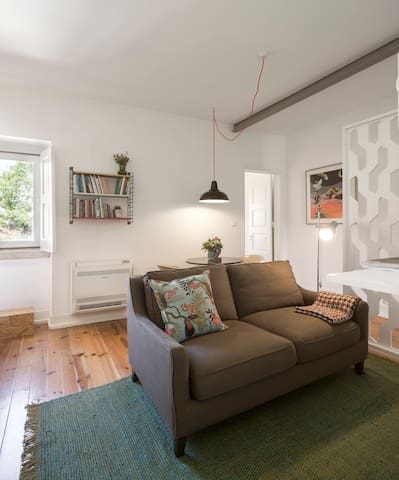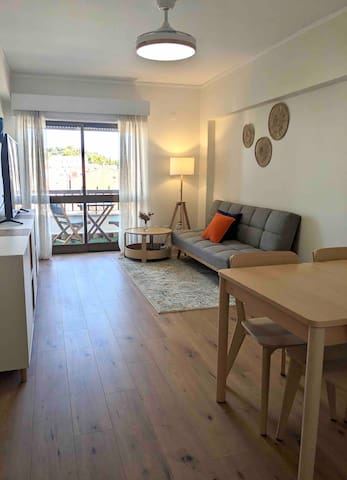托马尔 · 整套民居 · 1室2床1.0卫 · 可住3人 · São Gião House 4
托马尔整套民居1室2床1.0卫可住3人 · SãoGiãoHouse4

EN Located nearby the historical center of Tomar and a religious place protected by UNESCO, the ancient house, now rehabilitated by the atelier [A] ainda arquitectura, combines in a sublime way history and contemporaneity. The two story house has a 35 m2 living room with an open kitchen, a generous bedroom and a complete bathroom, being perfectly adapted to the current needs. The light is a dominant in the project and characterization of architecture, infusing life into the old places. Welcome to Tomar, a countrycity that with its charm, nature, history, country side is going to help you escape from the big cities rush, and will provide you calm and rest. You can visit several monuments, museums or take a tour by the countryside , where you can go trekking or practice water sports at Castelo do Bode dam. I hope you'll enjoy the visit!
房客评价
Don’t let the exterior fool you. This was a complete interior remodel and they did an excellent job. I loved the pictures displayed inside the house showing the extent of remodel. Beautiful quiet location with free parking.
Great location and within walking distance to food, shops and attractions. We did have to wait to get into the apartment but Ana’s communication was good. We enjoyed eating at Piri Piri Chicken, the food was amazing and the wait staff was informative and kind. The pictures on the walls show what a beautiful job Ana did with the renovations. The apartment was spotless and the street was quiet. We would absolutely stay here again.
房源位置
July 2019 Festival of Trays
https://www.rtp.pt/noticias/pais/tomar-o-grande-tabuleiro_es1153422?fbclid=IwAR2PkRfPlA33bLpP-feWLNy-V6GuWtTWqqePXnQdViCGUBZdXAVfTEmM6F8
HORÁRIO DOS MONUMENTOS
Horario de los Monumentos | Monuments Opening Times | Horaire des Monuments
Verão | Verano | Summer | Été
Convento de Cristo – Castelo dos Templários
9H00 17H30 (última entrada 17H00)
Tel.: (00351) 249 313 481 (00351) 249 315 089 www.conventocristo.pt geral@ccristo.dgpc.pt
Igreja de S. João Baptista
10H00 – 12H00 14H00 - 18H00 (2a Feira a Domingo)
Museu dos Fósforos
10H00 – 13H00 14H00 - 18H00 (3a Feira a Domingo)
Sinagoga
10H00 - 13H0014H00 - 18H00 (3a Feira a Domingo)
Igreja de Sta Maria do Olival
10H00 - 13H00 14H00 - 18H00 (3a Feira a Domingo)
NAC 1 – Núcleo de Arte Contemporânea
Capela de Santa Iria
14H00 18H00 (4a Feira a Domingo)
Casa Memória Lopes Graça
14H00 18H00 (4a Feira a Domingo)
Casa Manuel Guimarães
14H00 18H00 (4a Feira a Domingo)
Igreja da Misericórdia
Encerrada
NAC 2 – Edifício do Turismo - 1oandar
9H30 18H00 (4a Feira a Domingo)
Capela de S. Gregório
Encerrada
14H00 18H00 (4a Feira a Domingo)
Posto de Turismo de Tomar
Av. Dr. Cândido Madureira (junto à Mata Nacional dos 7 Montes) 9H30 - 18H00
Tel.: (00351) 249 329 823
www.cm-tomar.pt turismo@cm-tomar.pt GPS: 39o 36’ 6,0726’’ N / 008o 24’ 56,2068’’ W
Encerra nos feriados: 1 de janeiro, 1 de maio e 25 de dezembro
Tourism in Tomar
I- Chapels and Churches
Santa Iria Chapel
The church of the legendary patron saint of Tomar has a remarkable stone Calvary and, in the panelled main chapel there is an elaborate decoration allusive to the symbols of the Holy Spirit.
The Coimbran Renaissance language is emphasised by the portico and the Nicolau Chanterène window. The inside is covered in diamond tipped 17th century tiles. The altarpiece of Christ on the Cross is attributed to João de Ruão.
Arco das Freiras is the aerial passage between the Clarissa Nuns of the Santa Iria Convent and the former Palace of Friar Anthony of Lisbon.
Summer schedule (April to September):
Wednesday to Sunday, 2.00 p.m. to 6.00 p.m.
Winter schedule (October to March):
Wednesday to Sunday, 2.00 p.m. to 5.00 p.m.
Our lady of the Conceição Chapel
A small basilican church with three naves, built as a funeral chapel for D. João III, the king who ordered that it be built in 1547.
This fine example of Italian Classicism, conceived by João de Castilho is the best evocation of Greek - Roman art in the Iberian Peninsula.
The application of the Florentine urban style is noteworthy, as are the austere sobriety of the proportions, the windows positioned according to the direction of the sun, and, inside, the interweaving of objects between the naves and the transept, the dramatic vibration of natural light and the Corinthian decoration on the capitals.
Chapel built between 1532 and 1540 in pure Renaissance style, begun by João de Castilho and finished by Diogo de Torralva. It was intended to be the burial chapel of King John III. Its beautiful and clear architecture turns it into one of the most remarkable early Renaissance buildings in Portugal.
São Lourenço Chapel
This was the spot where, on 10th August 1385, the day of the martyr S. Lourenço, the troops of D. João I joined those of Constable D. Nuno Álvares Pereira on their way to Aljubarrota.
The Chapel and Monument mark the meeting place and the patron saint of the Chapel gave his name to the place.
Aires de Quental, whom D. Manuel I had given the task of building a weapons factory there, also built the Chapel.
Our Lady of the Piedade Chapel
The former chapel of Nossa Senhora da Piedade our do Monte that Alcaide de Óbidos had built in the 14th century.
You enter the covered porch through an ogival portal.
It was restored and modified in 1613 by the people’s judge, Bernardo Ortiz Ochoa.
The blue and white chequered tiles are 17th century, and the terrace and steps mid 19th century.
Santo António Chapel
It was built between 1953 and 1955, but contains architectural elements of a Renaissance chapel. In 1953 , with the construction of a Housing Project, built up the current chapel with architectural elements of the original.
Santa Maria do Olival Church (near Sao Giao House)
Gothic temple from the mid 13th century built on the site of a former temple built by D. Gualdim Pais.
The Pantheon of the Masters of the Templars was the headquarters of the nullius diocesis with jurisdiction over the churches of the Discoveries.
The interesting spatial structure with three naves served as a model for the São João Baptista church and other churches from the end of the Portuguese gothic period. Outside, the magnificent rose window is noteworthy, the lookout tower converted into a bell tower and the 16th century loggia; inside, the tombstone of Gualdim Pais, the tomb of D. Diogo Pinheiro and the images of Our Lady of Milk and the Holy Mothers.
This Gothic church (13th century) was built as a burial ground for the Templar Knights. Gualdim Pais, the founder of the city, was buried in the church and his original tomb slab, dated from 1195 and bearing a gothic inscription, is still preserved inside.
Schedule
Summer (April to September):
Tuesday to Sunday, 10 a.m. to 1 p.m. and 2 p.m. to 6 p.m.
Winter (October to March):
Tuesday to Sunday, 10 a.m. to 12 a.m. and 2 p.m. to 5 p.m.
Closed: Jan. 1, May 1 and Dec. 25
São João Baptista Church
Late gothic temple constructed on D. Manuel 1´s orders on top of the small chapel of the same name. It was completed at the beginning of the 16th century.
The symbology of D. Manuel (the Royal Coat of Arms, the Armillary Sphere and the Cross of Christ) are seen in the tower and again in the pulpit and the north and south portals.
On the outside is the tower with its three portals, the main one, the north and the south, reminiscent of an original temple.
The spatial structure of the naves is identical to that seen in the Santa Maria do Olival church and is enriched by the sculpted stone pulpit and the 16th century painting, the greatest exponent of 16th century Portuguese pictorial art.
The main church of Tomar is located in the main square of the town, in front of the Municipality (17th century) and a modern statue of Gualdim Pais. The church was built between the 15th and 16th centuries and has many interesting artistic details, like the flamboyant Gothic portal, the Manueline tower with a 16th century clock, the decorated capitals of the inner columns of the nave and several panels painted in the 1530s by one of Portugal's best Renaissance artists, Gregório Lopes.
Schedule
Summer (April to September):
Monday to Sunday, 10 a.m. to 12 a.m. and 2 p.m. to 6 p.m.
Winter (October to March):
Monday to Sunday, 10 a.m. to 12 a.m. and 2 p.m. to 5 p.m.
Misericórdia Church
King D. Manuel I in 1510 founded the Misericordy of Tomar.
The church of Nossa Senhora da Graça, or Nossa Senhora da Cadeia, is popularly known as the Misericord. A mannerist construction built in the second half of the 16th century.
The image of the patron saint fills the niche which completes the elegant 16th century portico.
Rectangular stone frames and chequered tiles decorate the nave.
Of special interest is the 16th century panel showing the Eucharistic miracle of Saint Anthony.
The Hospital substituted the Nossa Senhora da Graça Hospital (15th century) as a result of Prince Henry’s unification of all the hospitals and hospices in the town.
Schdule:
Temporarly closed.
São Francisco Convent and Church
The São Francisco Convent in a mannerist building set around two cloisters. It served the community after the Santa Cita house was closed.
In the mid 17th century it replaced the Nossa Senhora dos Anjos chapel.
A 17th century temple (1625-1660) is typical of Chã architecture. Mannerism is seen in the portal and the frontispiece of the façade.
On the inside, where a single nave is covered at great height by a barrel vault, are the sculptures of an extremely rare Calvary and the four pictorial representations of the life of the Virgin.
In the first chapel next to the Evangel, stands the image of Santa Iria, the patron saint of Tomar.
Schedule:
10 a.m. to 12 p.m. – 2 p.m. to 5 p.m.
Closed on public holidays, Jan. 1, May 1 and Dec. 25.
II- The Historic Centre
The Historic Centre
The layout of the medieval town is a cross with 4 arms pointing to 4 cardinal points marked by the 4 convents in the town. The centre, where the Town Hall and the Mother Church are situated, is the Praça da República. It is from here that the main public and religious buildings radiate: to the south, the Synagogue, the old Misericord Hospital, the S. Francisco Convent and the old town square; to the north, the seat of the Municipal Assembly, the Chapels of S. Gregório and Nossa Senhora da Piedade and the old Anunciada Convent; to the west, the CastIe hilI, the litle Senhora da Conceição chapel and the Convent of Christ; to the east, the bridge, the old MilIs and Presses, the Sta Iria Convent, the way to the Sta Maria do Olival Church and the school area ending with the Polytechnic. lf we follow this symbolic geometry, it is interesting to note that with the “Marnueline” church in the centre, the Praça da República, there is a circle that unites the Charola of the Convent (the Templar Oratory) to the Anunciada, Sta Iria and S. Francisco Convents. It was in this circle, in this holy space, that Tomar developed.
Windows
Tomar possesses a great variety of windows of historical and architectonic interest, each one with a story to tell. Further up, touching the eaves, gargoyles, both decorative and functional, watch over the streets.
And if in the Convent some of them are better known and reach greater heights of perfection, the Historic Centre is also an excellent place from which to observe them.
By the new bridge the windows tell us of lhe Inns. Above the vertex of the second arch, the oldest window and the only original 15th century one looks down onto Rua dos Arcos. Turn the corner into Rua Torres Pinheiro and you find another this time with an upper bar with decorative elements and a geometrical shape. Go round lhe block as for as Rua da Saboaria and you will find simply designed popular houses, on two levels, with an outer staircase covered by a porch. Nearby, right at the beginning of Avenida Cândido Madureira on the left, immediately after a large building that houses a department of the Polytechnic, you will see the front of a popular house with its spotless white windows and walls, scattered with flower post reminiscent of Andalusian patios.
Walking up the street, you will find the Casa dos Tectos, a 17th century building with guiliotine windows with geometric shapes on the apron. Next to this is the Tourism Office building, from the 1930’s Havanezabut with Renaissance doors and windows, which had belonged to old buildings in other parts of the town. You enter via a late 15th century doorway probably from the ‘Cubos’ (14th century granaries that were in what was the Praça da Ribeira); inside there is a double doorway. You can also see a corner window and three from the Renaissance, two of which are paired; one is original, the other a replica. On the outside of the building, you can see a sundial and gargoyles with lion´s heads.
Retracing your steps back to the Avenida Cândido Madureira, and turning the corner into Travessa do Arco, you will pass under the typical arch which joins the two parts of the Palácio dos Velhos de Macedo, a 16th century building; at the end of the little street, there are guillotine windows with round-shaped aprons as well as a late-Renaissance corner window overlooking Rua Pedro Dias, where the Solar dos Calça Perra, a property that belonged to that wealthy family in lhe 14th and 15th centuries, stands out. Continue to the right until you reach Rua dos Moinhos, where you take a left towards the Courredora. When you reach the point where the street you are on crosses Rua Joaquim Jacinto, there is a ‘Manueline” window and, at nº 63, an interesting doorway, the decoration of which suggests two compasses that could indicate the owner’s profession, (builder ar stonemason).
In front of you on Rua Infantaria 15, there is a building with elaborate balconies and 17th century windows, worth looking at.
Further on, on Rua Aurora de Macedo, just before the hill rises to the castle, there are two 16th century windows with simple aprons and a doorway from the samee period. After this you go into Rua do Pé da Costa and turn right until you reach the Praça da República. Going down you find an 18th century palace with beautiful stonework and gargoyles also seen on the church tower.
On your right, try to make out what the sculpture at the centre of the platband might be. Some think is a warrior, others the Archangel St. Michael and others even think it could be St. George.
Now, go along the Corredoura and you will see on both sides of the street tiIed-fronted buildings and features of both Art Nouveau and Art Deco styles.
The building that housed lhe old Barateiro stores is a superb example of aplomb and blue elegance of real splendour. The blue edged with yellow is seen in the untiled details in the entire façade. Approximately halfway down the street there are two more examples of tiled-fronted buildings, wrought iron balconies and delightfully delicate friezes.
At the top of the street before the Templars Regional Tourist Office, which has gutters rather than simple gargoyles, there are three buildings on your right as you go down the street, all predominantly blue. Note the penultimate one, with its unusual balustrade and the last one with an even more unusual blue façade imbued with allusions to Tomar.
Go around the Casa Vieira Guimarães, built in 1922 in neo-manueline style. Note the detail in each metal fixture held by a console with a different floral motif. Walk along by the river until you come to Rua do Camarão, where on the right a nº 45 you will see one of the prettiest windows in Tomar.
Finally, in Rua Silva Magalhães, find João Castilho’s Renaissance house that used to be the town library (now called Casa Manuel Guimarães), which has a corner window with balustrades, considered to be a national monument.
III- Museums
Matchbox Museum
There is a collection of over 80,000 matchboxes, labels and books ofn matches, donated by Aquiles da Mota Lima to the City Counil in 1980, in the S. Francisco Convent. The colletcion began when Mota Lima and American lady exchanged matchboxes during a sea voyage en route to London for the Coronation of Queen Elizabeth II.
Schedule
Summer (April to September):
Tuesday to Saturday, 10 a.m. to 1 p.m. and 2 p.m. to 6 p.m.
Winter (October to March):
Tuesday to Saturday, 10 a.m. to 12 a.m. and 2 p.m. to 5 p.m.
Closed: Jan. 1, May 1 and Dec. 25
Municipal Museum - Contemporary Art Centre
Schedule
Summer (April to September):
Wednesday to Sunday, 2 p.m. to 6 p.m.
Winter (October to March):
Wednesday to Sunday, 2 p.m. to 5 p.m.
Closed: Jan. 1, May 1 and Dec. 25
The Luso-Hebrew Abraão Zacuto Museum (Synagogue)
This colletion in the Synagogue consists of gravestones, objects connected with Jewish Culture and religious items. Excavations carried out in the connecting room uncovered coins, household pottery and the heating system for heating water for the ritual "Mikva" bath.
TEMPORARLY CLOSED FOR WORKS:
Visit the temporary exhibition of the synagogue's estate from December 20, 2017 in the Complexo Cultural da Levada (João Carlos Everard street).
Tuesday to Saturday, 10 a.m. to 1 p.m. and 2 p.m. to 6 p.m.
Lopes-Graça Memorial House
Schedule
Summer (April to September):
Wednseday to Sunday, 2 p.m. to 6 p.m.
Winter (October to March):
Wednesday to Sunday, 2 p.m. to 5 p.m.
IV- Castle
CASTLE OF THE TEMPLARS
The Templar Castle/Convent of Christ was seat of the Order of the Temple until 1314, and of the Order of Christ from 1357. Part of the castle (1160) is the late 12th century octagonal “Charola”, a Romanesque sanctuary of eastern influence. UNESCO classified this site as a World Heritage Monument in 1983. It covers an area of 54,000m2, forty thousand of which is built on, which is roughly the area of an average medieval town. In actual fact, it is the largest area convered by any monument in Portugal and one of the largest in the world. convento 3
There are three aspects to consider in order to appreciate this place: the artistic, found in every linear or square metre you cross and of which thw main doorway, the Charola, the Chapter window and the D. João III Cloister are examples of excellence; the functional, in that its main function was to accommodate warrior-monks and reclusive monks. Where with the surrounding woodland Natura is ever present; and its double significante, first in the consolidation of a country, and then through its expansion throughout the worls in the service of Christ.The Castle has three walled enclosures, of which the most importante are those of the Charola and the donjon. The great innovation came with the portentous base supports, which strengthen the fortifications.
Between the fortress and the Charola, in the area where in the 15Th century the Prince held court, there are traces of Muslim occupation.The initial building of the Convent is owed to Infante D. Henrique who, as well as building his court here, also built the washing and the cemetery cloisters. In the 1500’s another seven were added. There are hardly any buildings in the worls with as many cloisters, making the Convent a particulary significant example. Portuguese architecture is extremely well documented here, confirming that the buildings evolved with their residents: the Templar church/ rotunda in the castle is Romanesque; the Gothic is seen in the cloisters from the time of Infante D. Henrique; at the start of the 16th century, all the exuberance of the Manueline style is on show in the Chapter window; the Renaissance is seen in the alargement of the convent from D. João III until the 18th century; Mannerism and the Baroque leave their mark on the Hostel Cloister, the main one and on many ornaments. The intervention of D. João V can be seen in the pulpit, the altar, the chancel and the main sacristy.When the Count of Tomar, Costa Cabral acquired the complex in the 19th century the first guard post for the convent was crated in 1843 and since then it has officially had a public cultural function and been supported by the Exchenquer. Only in 1986 did this service come under the jurisdiction of the government´s cultural department.
Address:
Colina do Castelo
2300-000 TOMAR
Tel.: (+351) 249 315 089
Tel.: (+351) 249 313 434
Tel.: (+351) 249 313 481 (portaria do monumento)
Fax: (+351) 249 322 730
geral@ccristo.dgpc.pt
www.conventocristo.pt
icon facebook32
GPS:
39º 36' 14.8536" N
8° 25' 9.231" W
Tickets
Schedule:
Winter (October to May) 9h to 17h30 (Last entry 17h00)
Summer (June to September) 9h to 18h30 (Last entry 18h00)
Closed on public holidays, January 1, Easter, May 1 and December 25.
MILITUM XPISTI
The Order of the Templars was a medieval religious and military Order (12th/14th centuries) and in 1160 its Portuguese headquarters was established in Tomar, thirty-four years aftet arriving in Portugal. The Order was created to defend the HoIy Sites in Palestine and was designated “Order of the Temple or Templars” due to the fact that, in 1119, the first Christian king in Jerusalem, Balduina of Bologna, had agreed to allow one wing of his palace, installed in the AI Aqsa Mosque (which had been built on top of what had been the Temple of Solomon), to be used to set up the Order. The Templars motto guided the life of the Knights who had to take vows of poverty, chastity and obedience, fast and eat from the some wooden bowl. Their motto (“Non nobis domine non nobis sed nomine tuo da gloriam’, - Not for us Lord, not foi us but for the glory of Thy name.) is written on the Orderis quadrangular standard encircling the black and white background to the “Pátea” cross.The standard is called Baucent, also the Knights war cry. templario
The Knights wore coats of mail, helmets, and iron footwear, beneath a white cloak on which there was a large red cross and carried a shield, a lance, a club, a dagger anda sword. The Cross adopted in 1146 by lhe Knights of the Templars was of oriental origin and had already been in use for many centuries. It became common due to the expansion of Christianity in lhe Near East, namely the Eastern Roman Empire (Byzantium). It is called a ‘pátea” cross because it has curvilinear arms, which become wider from the centre to the ends.The circular Templar seal bears lhe inscription ‘Siglium Militum Xpisti’ around the edge with two knighls mounted on one horse in the centre.Right after it had been established, the Order spread throughout Europe, reaching the County of Portucale in 1126. The first documented reference to the Order was in 1128.It was D. Teresa, the mother of D. Afonso Henriques, who understood the importance of the Templars for the County, granting them Soure and all the territory between Coimbra and Leiria. With Portugal established as an independent kingdom, the expansion of the country southwards was assured by the conquest of Santarém in 1147. The military defence of the territory was reinforced further south in Tomar when D. Afonso Henriques granted this area to the Templars. Medieval Tomar was thus founded with the building of the Castle being started on March 1st 1160 (until the Gregorian calendar came into effect, this date had marked the start of the civil year, which was in fact linked to the Spring equinox and the Templars initiation ceremonies and could well have had a considerable influence on the choice of the symbolic moment at which to set up the Order).From that time on, the Order had its Seal, Pantheon (Santa Maria do Olival Church) and convent (mi the same church) until it was dissolved in 1312.The fall of S. João de Acre ( 291), the last bastion oftlhe Near East, caused the flight of the surviving Templars, one of whom was Jacques de Molay who was to become the last elected Templar Grand Master of Jerusalém and France.The return opf the Templars from the Holy Land and their enormous wealth gave the French King, Phillip the Fair, reasons to accuse them of heresy. He succededpersuading the Pope to suspend their privileges, weakeningtheir position in the Church, confiscated their property, arrested the Knights and had the Grand Master burnt alive along with his closest companions. The Pope dissolved the Order and donated their wealth to the Order of the Hospital. The consequences were immediate and the Order broke up in all areas. In Portugal, however, D. Dinis opposed the process and succeeded in preventing Templar property being handed over to the Order of the Hospital, creating forthwith Order of Christ (1319), which inherited the legacy of the Temple.
CONVENT OF CHRIST
THE CHAPTER WINDOW
This is the most symbolic of the five windows in the Lower Chancel of the Convent church (the 5 manueline windows as a set become more symbolic if we think of the 5 empires/ the 5th empire and the Pentecost). A prime example of Manueline Art, it has become an icon od Portuguese heritage, full of allusions to the Discoveries and the history of Portugal. The profusion of typical manueline decorative elements and its intense symbolism make it a major reference for Portuguese Art. The façade into which it is set is an immense peiece of artistry which complementes its meaning and recalls other allusions, includingthe fact that the trays from the Tray´s Festival had been inspired by the bultresses on the side of the window.
TEMPLAR CHAROLA
This was lhe oratory of the Order of the Templars in the Castle. lt is a compact, cylindrical structure with eastern influences from lhe 12th/13th centuries and undoubtledly mililary in order to protect the sacred, alluding to the Holy Sepulchre of Jerusalem.convento 6 On lhe inside it houses a central octogonal tambour with eight pillars, each composed of four addorsed columns, allowing ample room to pass through. In the early 1500´s, a wide arch was opened to the chancel that was it by an oculus, which on the outside was part of the decoration of the Chapter window. Diogo de Arruda did this work in the eral 16th century; João de Castilho was given the task of connecting the Chancel to the Charola by an annular vault. The entrance, a portentous doorway and richly decorated façade, are also by Castilho. The decoration of the Charola consists of Motifs on the structure of the tambour, paintings on the annular vault, wall paintings on the second level of the tambour (representing instruments of the Passion of Christ, by Fernãio Anes), eight of the fourteen originl panels are on the perimeter wall (by Jorge Afonso), wooden sculptures (representing Angels, Saints and Prophets) and a set of the Virgin with St. Jonh by Olivier de Gand.
THE MAIN CLOISTER
This is the most important and emblematic of the cloisters of the Convent of Christ, it was the cloister for meditation, processions and prayer. A masterpiece of Renassance architecture, designed by Diogo de Torralva, it has strong Italian lines and influences, though it was Filipe Terzi who completed it. However it was Castilho who had slarted it under D. Joao lIl’s orders, but work was stopped after the death of the king on lhe orders of the regent D. Catarina, for it to be altered according to new canons. It is a well-known fact that the work done previously by Castillo lies alongside that of Torralva, who replaced him, so much so that you can step into spaces designed by the latter without actually leaving the more “real” part, which is why this space is often referred to as the two cloisters ralher than one. The cloister has two floors, the last of which is a terrace with a balustrade (the Wax Terrace). The patio has a central baroque fountain in the shape of a cross of Christ, designed by Pedro Fernandes de Torres. Water, at that time was supplied by the Peges Aqueduct and thus the Fountain symbolically announced the arrival of water. It was in 2004 that the fountain started working again but now using lhe public water supply.
THE ALMEDINA GATE
In the castle walls there was an entrance gate to the “almedina” or little town, alsoknows as “St. Martínis district”. In the 16th century, on D. joão III’s orders, the Convent was adapted for use by a closed order, which meant demolishing this part (both inside and outside the walls). Thus, the gate was no longer in use and was closed. It is also knows as the “Gate of Bloods”, because a Muslim attack there in 1190 caused great bloodshed.
Address:
Igreja do Castelo Templário
2300-000 TOMAR
Tel.: (+351) 249 315 089/
Tel.: (+351) 249 313 434
Tel.: (+351) 249 313 481 (portaria do monumento)
Fax: (+351) 249 322 730
geral@ccristo.dgpc.pt
www.conventocristo.pt
icon facebook32
GPS:
39º 36' 14.8536" N
8° 25' 9.231" W
Tickets
Schedule:
Winter (October to May) 9h to 17h30 (Last entry 17h00)
Summer (June to September) 9h to 18h30 (Last entry 18h00)
Closed on public holidays, January 1, Easter, May 1 and December 25.
V- Festivals
SANTA IRIA'S FESTIVAL
October 2018
Date: October 12 - October 21
Location: Tomar Municipal Market
With procession in the Day of Santa Iria (20 October), fair of raisins, cultural animation and show of local products.
Friday 12
9:00 pm - Band of the Gualdim Pais Philharmonic Society
Saturday 13
8:30 pm - São Miguel de Carregueiros Folkloric Ranch
9.30 pm - Folkloric Ranch "The Canteiros" of the Quarry
22h30 - Payalvense Band Manoel de Mattos
Sunday 14
16h00 - Linhaceira Folkloric Ranch
17h00 - Folkloric Ranch "The Peasants" of Minhoelho
18h30 - Philharmonic Band of the Recreative and Musical Society of Pedreira
Wednesday 17
21.00 - Fado Night by the "Friends of the Fado de Tomar" Association, with the fado singers Vasco Serra; Ana Fernandes; Luís Filipe Fortunato; Rute Xavier; António Lourenço; Carmen Dolores, accompanied by Diogo Ferreira (Guitar) and Rui Girão (Viola), with presentation by António Leiria
Friday 19
10:00 am - Presentation of the book about Santa Iria of the students of the 12th year of the Graphic Arts course of the Templar Schools Group (Cultural Complex of Levada)
21h00 - Marcial Nabantina Republican Band Society
10.30 pm - Alviobeira Folk and Ethnographic Ranch
Saturday 20 (Day of Santa Iria)
10:00 a.m. - Mass in the Church of St. John the Baptist
11h00 - Procession
21:30 - 28th Anniversary of Radio City of Tomar (variety show)
Sunday 21
16h00 - Folkloric Ranch "The Peasants" of Peralva
17h00 - Folkloric Ranch "The Washerwomen" of Asseiceira
Inauguration of the fair:
Friday, October 12, 5:00 p.m.
Fair time:
Monday to Thursday, 3:00 p.m. to midnight
Fridays, 3:00 p.m. to 1:00 p.m.
Saturdays, 11:00 a.m. to 01:00 a.m.
Sundays 11:00 a.m. to 12:00 p.m.
Organization: Municipality of Tomar
THE FESTIVAL OF TRAYS (29th June to 8thJuly 2019)
The Trays Festival is held every four years in early July. It has origins in the Cult of the Holy Spirit, which began in the 16th century, but we can see in it traces of earlier harvest festivals, such as in the profusion of flowers and the fact that bread and ears of wheat are present on the trays.
The Procession, which is the high point of the festivities, takes place alongside a wealth of cultural and recreational events, the most important of which are the Boy’s Procession, the “Mordomos’s” Procession, the decorating of the popular streets, the popular games, the Partial Processions, the popular parties and the “Pêza”.
The Festival starts on Easter Sunday when the Crowns and Standards representing all the parishes are brought out in a processionenlivened by pipers, drummers, firework launchers and bands. From this point on, this is repeated seven times but with the Crowns and Standards of the town and just a few on the parishes each time. As children are not allowed to take part in the big procession, the Boy’s procession was created so that the children could have their own festival. The Boy’s procession is an exact copy of the adults one but it in held on the previous Sunday. Children from Nursery and Primary school take part.
Festa 2On the Friday before the Main Procession there is the “Mordomo’s” Procession, simbolising the entrance into the town of the sacrificial oxen, which, in the past, would have been slaughtered, and the meat distributed to the poor. In the past this procession was called the Procession of the Holy Spirit; today it is an impressive procession of carts and people on horseback with pairs of oxen at the head.
The streets of the historic centre are closed to traffic and decorated with millions of hand made paper flowers, which represent months of intense but enthusiastic work.
On the morning of the Saturday before the Main Procession, the Partial Processions come from the parishes; hundreds of Trays that will be paraded the next day. That afternoon, the traditional popular games are held in the Municipal Stadium (races with jars and barrels, tugs of war, climbing the greasy pole, quoits).
On the Sunday, the Procession of Trays starts with the pipers and drummers. Next come the Standard of the Holy Spirit and the three Crowns of the Emperors and Kings. After that come the Standards and Crowns of all the parishes.
The Procession is an immense weaving train of colour and music, made up for hundreds of pairs: the girls in white, with a broad ribbon tied across their front, carrying the tray on their heads; the boys in white shirts with sleesves rolled up, black trousers, a berent on their shoulder and a tie that matches the colour of the girl’s ribbon.
The triumphal carts of breads, meat and wine, pulled by the symbolic sacrificial oxen, bring up the rear of the procession.
The Trays the symbol and main decorative feature of the Festival of Trays. It should be the same height as the girl who carries it. It is decorated with paper flowers, greenery and ears of wheat. It also made up with 30 bread rools of a special size, each wighing 400 grams, threaded onto 5 or 6 canes. The later emerge from a wicker basket, wich is wrapped in a white embroidered cloth, and on top it isfinished off with Cross of Christ or a Dove of the Holy Spirit, the girl’s outfit consists of a long, white dress with a coloured ribbon across the front; the boy’s one is a simple, white shirt with sleeves rolled up, dark trousers, black beret on the shoulder and a tie the same colour as the girl’s ribbon.
On the Monday afterv the Procession, to round off the Festival, tradition and solidarity demand that meat, bread and wine that were blessed the previous day – the “Pêza” – should be distributed to the needy.
VI- Pegões Aqueduct
Situated near Tomar, over the valley of the Ribeira dos Pegões, the Pegões Aqueduct is one of the largest and most imposing Portuguese aqueducts.
It was built at the end of the 19th century. XVI and principles of the century. XVII, at the behest of Philip I, to supply the Convent of Christ with water. The history of this aqueduct is therefore strongly linked to that of the convent.
However, in spite of its large size and its reasonable state of conservation, the Pegões Altos Aqueduct is relatively little known and is not even mentioned by most of the tour guides, who for the city of Tomar only refer to the convent and one or the other church. So anyone who sees this monument for the first time will certainly be amazed to discover that there is an aqueduct of this greatness so close to the city.
The Pegões Aqueduct has a total length of about 5 to 6 km and in the larger section reaches a maximum height of 30 meters. Here the construction is composed of two rows of arches, the upper ones being round and the lower ones the ogivais. Originally the aqueduct was supplied by three water mothers.
The aqueduct can be traversed on foot along its upper part, as there is a platform that accompanies the water gutter. This journey is a unique experience, since the other Portuguese aqueducts can not be traveled freely.
VII-The dam of Castelo de Bode and the legacy of the Templars
The meandering of the course of the River Zêzere guides us to a magnificent lake between the shale and magical mountains of the county of Tomar. In this area you can visit and enjoy the Castelo de Bode Dam, one of the main buildings in the set of dams in the Zêzere basin and one of the largest dams in the country.
Located in Tomar, the dam bathes several lands once controlled by the Order of the Templars and that maintain an aura of mystery that fascinates all who visit them. The best known is Dornes, in the mythical peninsula that lends its name to it. The presence of the Order of the Templars is well visible in the pentagonal bell tower of Dornes, which survives almost intact until our days.
For those in love with the legends that haunt the history of the Templars, a careful and attentive visit to the region is indispensable. But the most exciting feature of the Castelo de Bode Dam is its beautiful lagoons, which originated some of the most extraordinary river beaches in the country.
Two of them, Alverangel Fluvial Beach and Fluvial Beach of the Montes, were distinguished in 2016 by QUERCUS with the classification of "Quality of Gold". Praia dos Montes, for example, is in a green area where several fountains flow. Castanheira Fluvial Beach - also known as Lago Azul - is another reference beach in Portugal. Here, the dam's waters reflect a magnificent and particularly intense blue. The tranquility of the "lake", surrounded by the mountains, makes it one of the most relaxing and unforgettable areas off the dam.
In addition, it is a privileged place to practice water sports, namely wakeboarding, windsurfing, sailing, rowing, jet skiing, nautical and sport fishing (trout, bass, eel, red crayfish). Finally, we highlight the River Beach of Aldeia de Mato. Distinguished several times with blue flag, its calm waters are ideal to practice swimming or simply relax in the entree of the Nature.
Free parking na rua da Casa de São Gião
爱彼迎旅行保障

安心房源保障 人工审核所有中国房源信息,入住更安心

专业中文客服 通过客服电话、线上客服、智能客服助手等渠道,为您提供全方位服务

旅行安全保障 多重风险控制设计,全方位保障您的行程安全
更多托马尔民宿推荐
继续探索更多目的地
其它民宿
- 【隐市民宿】林荫胡同 禅茶一味日式榻榻米双大床房(独立观景阳台大窗 禅意品茗休闲区)
- 金沙滩阿涛海景公寓
- 万平口观海大三居
- 小松鼠,三房两厅1卫(近长隆海洋王国)
- 【超值特惠】奇异空间‖轻奢浴缸‖永宁门夜景‖高清投影‖地铁&机场站点
- 【岚海 一舍】room4城市中心五星级酒店旁的山景公寓可月租
- 【熊猫】春熙路/每日消毒/宽窄巷子/市中心/整面落地窗温馨一居
- 三亚湾稀缺180度海景两房♥躺在床上看海♥椰梦长廊♥4晚免费接机+能满足全家人的看海梦
- 台南親子民宿✪彩色鯨魚4人家庭溜滑梯房(有球池),近赤嵌樓,大天后宮
- New Private Villa Antique Style @ Govinda Farm
- 展开更多
